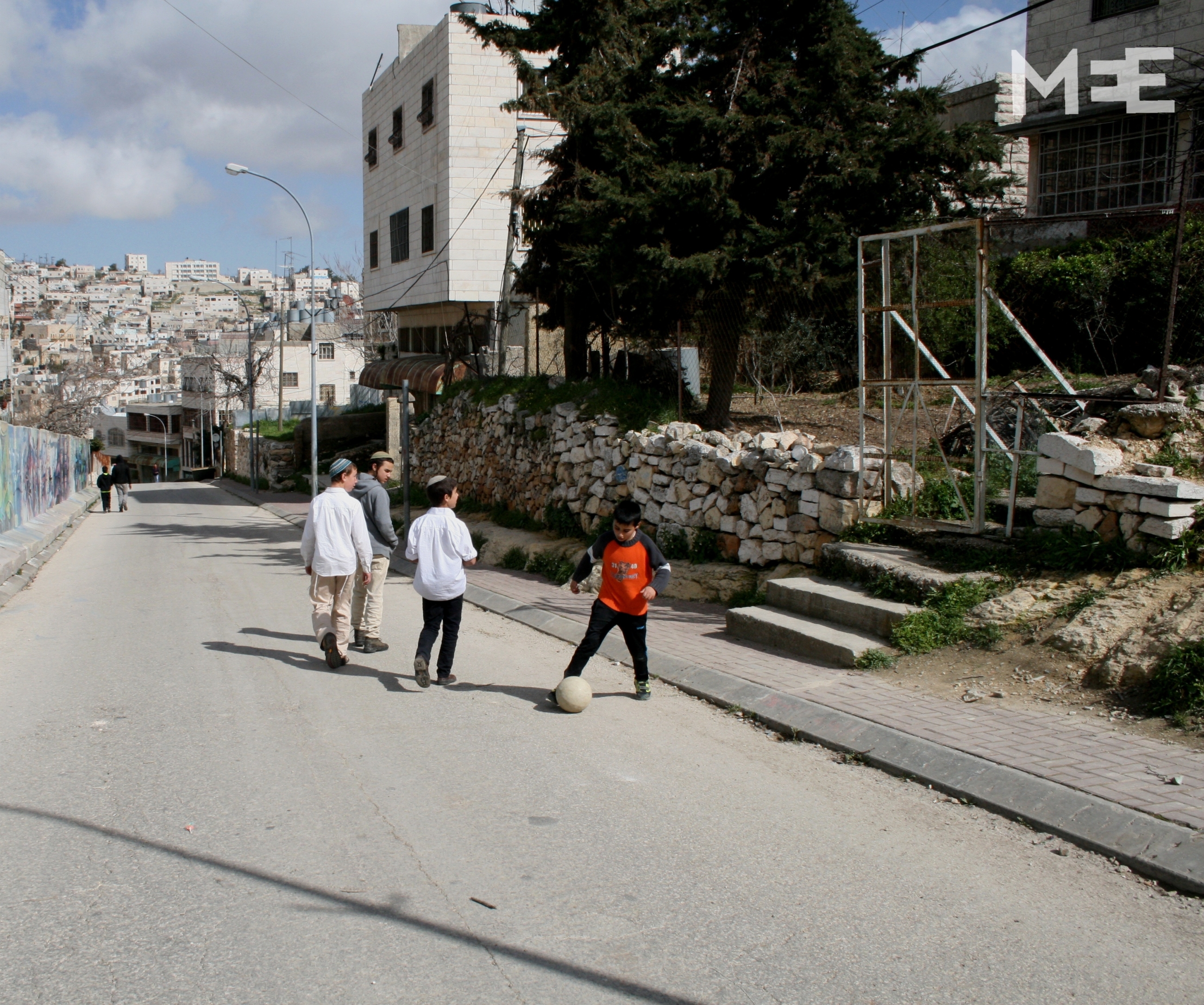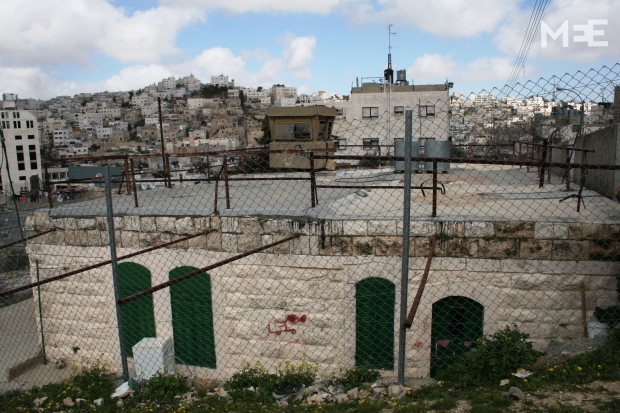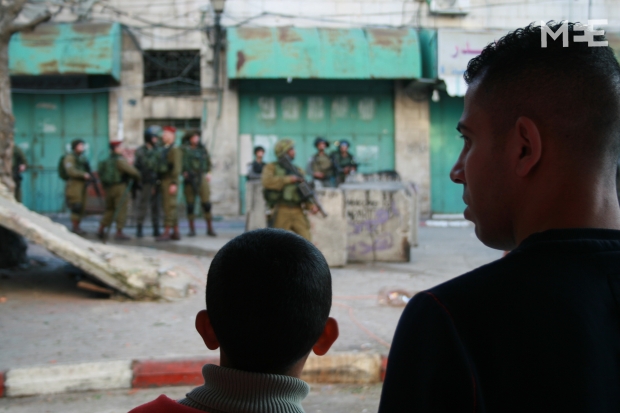Growing up in the massacre's shadow: Children of Hebron

Twenty-one years ago, Israeli settler Baruch Goldstein dressed in military uniform entered the Ibrahimi Mosque and opened fire, shooting 29 worshippers and injuring over 100 others as they knelt at prayer. One of the first community responders to the incident, Emad Shamsiyeh talks to Middle East Eye about growing up in Hebron and the legacy the Goldstein massacre has left on the lives of his children.
25 February, 1994: “It was Ramadan, we woke early for sahur [breakfast]. I lived with my parents close to the mosque. We heard shooting and went out into the street. The first person I saw was a man called Zain, he could hardly speak as he had a bullet in his side but told me there had been a massacre. There were no mobiles then so I began shouting loudly to tell people what had happened. My neighbour took Zain to hospital.
A big group formed, old and young, men and women and went into the mosque. We could still hear the sound of gun shots. When we got close to the entrance, the soldiers started to shoot at us so we split up. Some of us entered from a different entrance and saw many people shouting ‘Allahu Akbar’ (God is great). About 20 older people went inside and started to carry people out, some were injured and some were dead. Private cars started taking people before the ambulances, I was in the second car.
Me and the driver carried three, they had bullets in their heads and shoulders as they had been kneeling to pray. They were already dead. I took them to Hebron hospital which was full and they told me to go to al-Ahli hospital where they put them in a room with other dead people. After half an hour the hospital announced that they needed blood, we could still hear the shooting of the soldiers. Many young came to give blood. A man I know left the hospital after giving blood - he was standing outside drinking juice and they shot him with a bullet in his back. It was a very difficult day I will never forget.”
Punishing the victims
One dictionary definition of the word “legacy” is “something handed down from the past, as from an ancestor or predecessor.” Many of us hope to leave a positive imprint in the world, do our bit to make the world a better place or to have a small impact which has touched the lives of others.
I asked Emad about Goldstein’s legacy in Hebron. In the immediate aftermath, the mosque closed for months and was divided into two parts. Israeli military checkpoints were installed everywhere and scared Palestinian families abandoned shops and homes. Since then, thousands of shops have closed. Shuhada Street, once the vibrant and lively commercial hub is desolate and oppressive, closed to Palestinians while Israelis and internationals wander freely. The legacy lives on in what resembles an eerie and ominous ghost town under heavy surveillance. “They punished the victims.” Emad says.
Another local man, Hamed Qawasmeh told me that local school children know Goldstein’s name by heart and the number of closures, lack of access to Shuhada Street, heavy presence of Israeli forces and frequent settler violence is “the reward awarded for his criminal act”.
Living in cages
Cages are generally built to keep things inside, in Hebron they are built to keep things out. Emad’s is not the only home in Tel Rumeida to be surrounded by a metal cage, built to protect families from settler aggression. A few rocks thrown yesterday sit on top of the mesh. Behind the home, an ugly concrete wall erected by the military is spray painted with the words “Artists 4 Israel”.
The roof was declared a military zone in the year 2000 after the army installed a watchtower on it. The insulation was damaged and it now leaks and paint peels from the walls inside. The family were denied permission to repair it. The day I visit, the watchtower is unmanned but soldiers sit a few metres away in two separate outposts. Emad shows me the reasons for the heavy military presence in the area - two large settlements comprising a large house and a few orange caravans housing three settler families including the notorious Hebron settler, Baruch Marzel.
Generational resistance
Emad describes growing up in Hebron, he tells me his grandmother was “a martyr” killed in the 1967 war and that he comes from a “resistance family”. Throughout his childhood he became gradually more aware of the occupation. When he was eight, he saw his grandfather taken from the house by the army. Over the years he watched his uncles and father being arrested for their resistance. He watched soldiers destroying the family furniture and calling his mother dirty names.
By the time the First Intifada began, still just 15, he was participating in demonstrations himself. In 1988 he was shot twice in his elbow, He shows me his arm which he now has limited use of. He spent years in Israeli jails under administrative detention and describes various torture methods he went through under interrogation.
Now that he's a married father of five, I ask him about the differences between his childhood and the lives of his children. Without hesitation, he says how much worse things are today, politically and economically. He talks wistfully of a time Palestinians could work in Israel and says how much better the economy was then. “There was no Chinese stuff in our markets. Now there is no business.’’
Emad stops talking, looks out of the window and points, mustawteneen (settlers) he says. A group of settlers stand at his gate for five minutes talking and pointing. I poke my head out, “Salam aleikum,” one says looking surprised to see a blonde haired woman with a camera. “They only said that because you are here.” says Emad.
Tel Rumeida is renowned for being home to a number of fanatical and violent settlers. Every member of the Shamsiyeh family has experienced violence and harassment. At the age of 12, Madlin Shamsiyeh’s jaw was broken when settlers threw rocks at her from a rooftop on her way to school. No one was arrested for this, settler crimes often go unpunished. As we are talking, Emad’s youngest son Saleh comes in and shows me two stitches in his arm, he was attacked last week with a metal object while playing in the snow.
Emad’s youngest daughter, Marwa is now 12. When she was eight, she left school early one day, the streets were empty and a group of settlers were walking behind her. When she reached the gate to the house, one of them put something in her hair which he then set on fire. Israeli soldiers witnessed this and put out the fire.
Emad said the family heard her screaming and that after the assault Marwa refused to go to school for a month. She needed therapy for two years he said. “She was a young girl you know, her hair was missing.’’ He shows me a video recorded last year showing his son Awne being knocked unconscious by a group of settlers. Chaotic scenes ensue as activists attempt to protect the family while being screamed at by settlers and soldiers.
Emad’s middle son Mohammed comes in, he tells me he wants to be a journalist when he’s older and that he attended the Open Shuhada Street demonstration yesterday. The demonstration is held yearly to commemorate the victims of the massacre and is supported by internationals from all over the world who hold local demonstrations in solidarity.
The almost too predictable pattern of Palestinian demonstrations is that they begin peacefully with people holding flags, signs and chanting. When people get too close to a declared “military zone”, or a small child randomly throws a stone from the back or sometimes without no provocation whatsoever, things deteriorate fast as Israeli forces disperse crowds using sound bombs and tear gas.
When seasoned and hardy demonstrators are not deterred, they use rubber cased steel bullets or sometimes live ammunition is used. Last Friday’s Open Shuhada Street demonstration met an aggressive response as four Palestinians plus a German activist were shot. Mohammed says he wasn’t scared at all despite being hit by a sound bomb.
I ask him about life in Hebron, and he describes problems with settlers attacking and beating him and his friends. He describes being frequently stopped and searched by Israeli forces and says when he and his friends are playing football in the street, soldiers sometimes take the ball from them and cut it with a knife.
A member of Christian Peacemaker Teams claimed they’re more aware of military pressure at the moment, saying that there have been a lot of child arrests in the last few weeks with a boy being arrested while at school. They described more bag searches in the area and said that often children’s hands are checked for dust and if they have dust on their hands they are accused of throwing stones. Other locals have said this is due to the return of the infamous Golani brigade who have raided homes of local activists.
Liberation
I ask Emad what he wishes for the future of his children. “I hope my kids will grow up with a free life and to achieve all their own goals. On a personal level I hope that peace exists in Palestine and the occupation and settlers leave us and we have an independent country with Jerusalem as our capital.”
Emad’s wife, Fayzeh (meaning “winner” in Arabic) is the main breadwinner of the family and carries a camera with her wherever she goes. It’s her way of protecting her children. When neighbours ask for help, Fayzeh takes it to document incidents. She is also involved in a local women’s rights group.
Emad says it’s important for women to break out of conservative roles and that he supports and encourages her. “Women create society by their open mindedness and liberation. Before we are liberated we should be liberated from the rules and habits in our own lives.” he says.
Asked if he will encourage his daughters to do the same, he laughs. “They already do!” He tells me Madlin captured the photo of the German activist shot at the demonstration. I ask him if his family are unusual to put themselves at the frontline of the non-violent resistance, often in dangerous situations. He says people often ask if he is scared for them but he thinks it is important to teach children to break barriers and show people how they live in Palestine.
For me or against me?
Thousands of articles have been written about Hebron. A month after the massacre, the first groups of international observers were brought into the area. Today, 21 years later, at least four international teams with varying mandates are based permanently in the city, while thousands of international activists visit to show solidarity. I ask another local activist what has changed for the Palestinians with the overwhelming number of agencies, documentation and protection.
“Nothing, nothing has changed. They produce tons of reports, that’s all. I don’t know whether these reports are for me or against me.’’
As we leave the home, two female Israeli settlers bring flasks of coffee to the soldiers. A young settler child around 12 years of age stands chatting, draped across his back is a large wooden toy rifle.
In the shadow of Goldstein’s Hebron legacy, activists come and go, some injured or deported for their efforts. Abuses are logged, reports are written, hot spots of tension erupt spontaneously. Children and adults in Hebron document and send raw, immediate footage of their suffering out to the world and while they’re the first to admit that nothing is changing, their cameras have become their voice.
New MEE newsletter: Jerusalem Dispatch
Sign up to get the latest insights and analysis on Israel-Palestine, alongside Turkey Unpacked and other MEE newsletters
Middle East Eye delivers independent and unrivalled coverage and analysis of the Middle East, North Africa and beyond. To learn more about republishing this content and the associated fees, please fill out this form. More about MEE can be found here.







